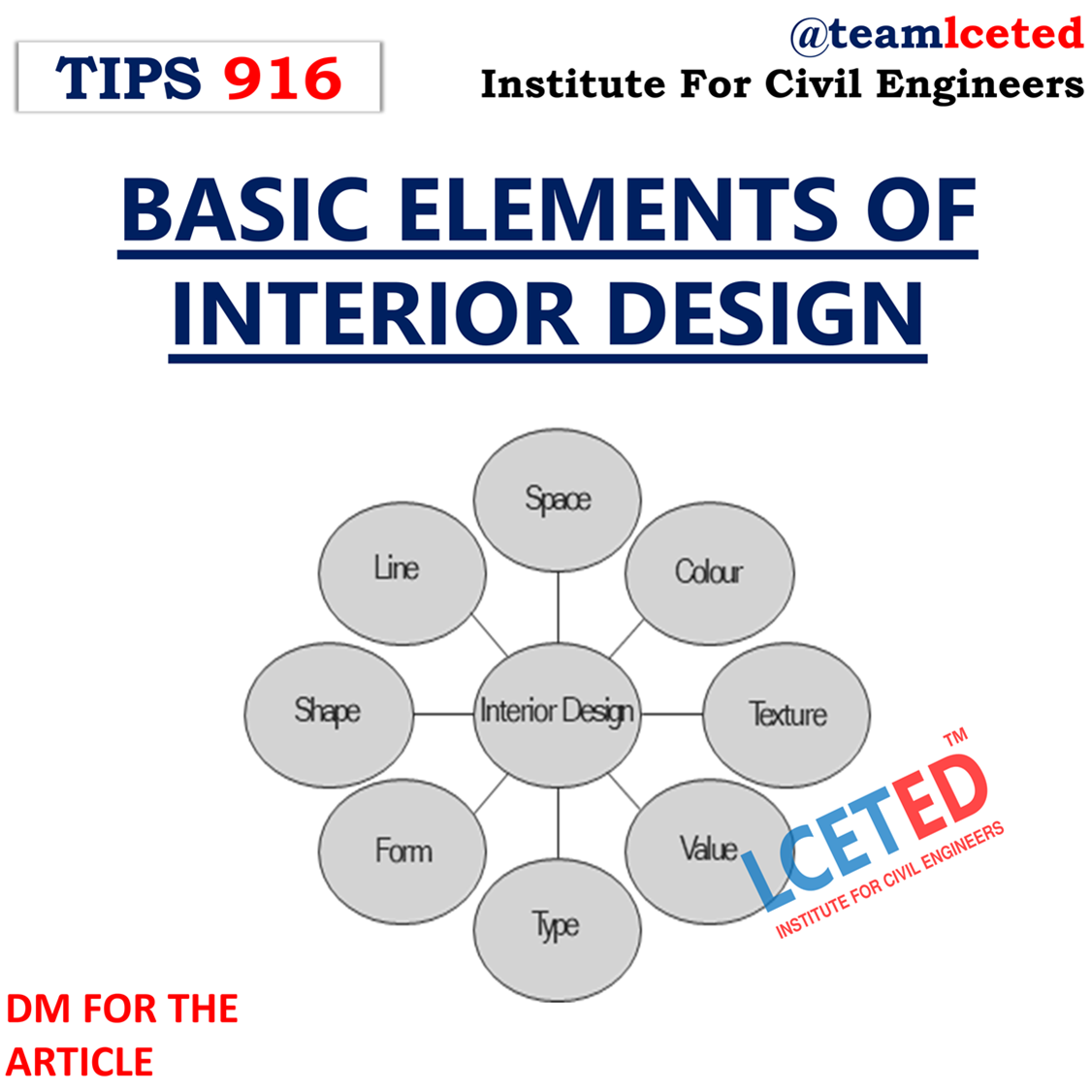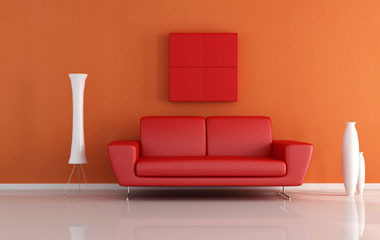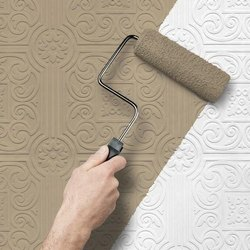In this article, we will discuss the 8 elements of interior design: Shape or Form, Colour, Texture, Light, Space, Type, Line, and Value. We'll also discuss the 8 principles of design: Proportion, Scale, Balance, Harmony, Unity and Variety, Rhythm, Emphasis
BASIC ELEMENTS AND DESIGN
PRINCIPLES OF INTERIOR DESIGN - LCETED
‘Interior design is a multi-faceted profession in which creative and
technical solutions are applied within a structure to achieve a built interior
environment. These solutions are functional, enhance the quality of life and
culture of the occupants, and are aesthetically attractive.
Must read: How To Design A Room Like An
Interior Designer - Lceted
Designs are created in response to and coordinated with the building
shell and acknowledge the physical location and social context of the project.
Designs must adhere to code and regulatory requirements, and encourage the
principles of environmental sustainability.
The interior design process follows a systematic and coordinated
methodology, including research, analysis and integration of knowledge into the
creative process, whereby the needs and resources of the client are satisfied
to produce an interior space that full-fills the project goals’
BASIC ELEMENTS OF
INTERIOR DESIGN
Elements of interior design
Shape or
Form
The shape is the primary means
by which we distinguish one form from another. Appealing interiors can be
designed using appropriate shapes. The
following are some categories of shapes:
Natural
shapes represent the images and forms of the natural world.
These shapes may be abstracted.
Non-objective
shapes make no obvious reference to a specific object or to a
particular matter. Some non-objective shapes may result from a process such as a calligraphy and carry meaning as symbols.
Geometric
shapes are of two types—rectilinear and curvilinear.
Curvilinear shapes are circular while rectilinear shapes include a series of
polygons, which can be inscribed within a circle. Extended into the third
dimension, these primary shapes generate the sphere, cylinder, cone, pyramid
and cube.
Colour
Colour plays an important
role in interior design. Specific colours can be used to enhance the
characteristics of a space based on its specific function.
Choosing
Colours for Different Places
(a)
Comfort Colours: The comfort colour palette is a good choice
for kitchens and family rooms since they wrap the room in warmth and comfort.
The most common comfort colours include biscuit and wheat neutrals; cocoa
browns, pumpkin oranges; and cinnamon apple-pie shades.
(b)
Natural Colours: Natural colours can be used as a delicate
accessory or a bold accent. They are great for bedrooms and bathrooms since
they remind a sense of the outdoors. Natural shades such as yellows, blues,
greens, and organic browns are often used in combination with rich metallic or
rust and copper accents.
(c)
Contrast Colours: Stark contrast colours such as deep reds,
plums, and brisk blacks and whites, all add an elegant touch of sophistication
to a room. Contrast colours can be used as an accent or an elegant backdrop.
They are mostly used in formal dining rooms, living areas or powder rooms with
polished brass and metallic decorations as complementary accessories.
Texture
The texture is the visual or physical feel of the fabrics, colours, and other elements. There are two types of texture—visual texture and texture which you can sense with your five senses.
Light
The first function of
lighting design is to illuminate the form and space of an interior environment
and allow users to undertake activities and perform tasks with appropriate
speed, accuracy, and comfort. There are three methods for illuminating a space:
• Ambient or general lighting
• Task or local lighting
• Accent lighting
Ambient
or General Lighting: General or, ambient, lighting illuminates
a room in a fairly uniform, general diffuse manner. General lighting can also
be used to soften shadows, smooth out and expand the corners of a room and
provide a comfortable level of illumination for safe movement and general
maintenance.
Task
Lighting: Local or task lighting illuminates specific areas of space for the performance of visual tasks or activities. The light sources are
usually placed close to either above or beside the task surface.
Accent
Lighting: Accent lighting is a form of local lighting, which
creates focal points or rhythmic patterns of light and dark within a space.
Accent lighting is used to emphasise a room’s features or highlight art objects
or prized possessions.
Natural
Light: The building should be constructed in such a way that
the daylight can be utilised to a maximum for routine activities inside the
building. The number and size of openings such as windows, ventilators, doors,
etc., in the building should be designed in such a way so as to get more
natural light. Natural light should not create any shade or glare.
Daylight
Factor: The ratio of illumination at the working place inside a
room to the total light available outside is called the daylight factor.
Recommended daylight factor
|
Living room |
0.625% |
|
Study room |
1.9% |
|
Bedroom |
0.313% |
|
Kitchen |
2.5% |
Space
Space is the area provided for a particular purpose. It
may be two-dimensional (length and width), such as a floor, or it may be
three-dimensional (length, width, and height), such as a room. Space includes
the background, foreground and middle ground.
Type
Type is the use of letter form to convey a message which
would be difficult to convey using other elements.
Line
Line is a mark made by a moving point, such as a pencil or brush. The edges of shapes and forms also create lines. Lines and curves are the basic building blocks of two-dimensional shapes like a building’s plan.
Value
It gives objects depth and perception. Value is also
referred to as tone.
DESIGN PRINCIPLES OF
INTERIOR DESIGN
Proportion
Proportion refers to the relationship of one part to
another or to the whole or between one object and another. This relationship
may be one of magnitude, quantity or degree.
Scale
Proportion pertains to the relationships between the
parts of a composition, while scale refers specifically to the size of
something, relative to some known standard or recognised constant.
Balance
Symmetrical
Balance: Symmetrical balance results from the arrangement of
identical elements, corresponding in shape, size and relative position, about a
common line or axis. It is also known as axial or bilateral symmetry.
Radial
Balance: Radial balance results from the arrangement of elements
about a centre point. The elements can focus inward toward the centre, face outward
from the centre, or simply be placed about a central element.
Asymmetrical
Balance: Asymmetry is recognised as the lack of correspondence
in size, shape, colour or relative position among the elements of a composition.
Elements that are visually forceful and attract our attention such as unusual
shapes, bright colours, dark values and variegated textures must be
counterbalanced by less forceful elements which are larger or placed farther
away from the centre of the composition.
Harmony
Harmony can be defined as
consonance or the pleasing agreement of parts or a combination of parts in a
composition. While balance achieves unity through the careful arrangement of
both similar and dissimilar elements, the principle of harmony involves the
careful selection of elements that share a common trait or characteristic, such
as shape, colour, texture or material.
Unity and
Variety
To get variety and
interest, include dissimilar elements and characteristics. For example,
asymmetrical balance produces equilibrium among elements that differ in size,
shape, colour or texture. Another method for organising a number of dissimilar
elements is simply to arrange them in close proximity to one another.
Rhythm
The design principle of
rhythm is based on the repetition of elements in space and time. This
repetition not only creates visual unity but also induces a rhythmic continuity
of movement.
The spacing of the
recurring elements, and thus the pace of the visual rhythm, can be varied to
create sets and subsets and to emphasise certain points in the pattern. The
resulting rhythm may be graceful and flowing or crisp and sharp.
Emphasis
The principle of emphasis assumes the coexistence of
dominant and subordinate elements in the composition of an interior setting. A point of emphasis can be created by a perceptible contrast in size, shape,
colour or value. An element or feature can also be visually emphasised by its
strategic position and orientation in space.
What are the requirements of an interior
designer?
FUNCTIONAL
REQUIREMENTS OF AN INTERIOR DESIGNER
A
professional interior designer is a person qualified by education, experience
and examination who
1) Analyses the client’s needs, goals and safety requirements
2) Integrates
findings with knowledge of interior design
3) Formulates
preliminary design concepts that are appropriate, functional and aesthetic
4) Develops and presents final design recommendations through appropriate presentation media
5) Prepares
working drawings and specifications for non-load bearing interior construction,
materials, finishes, space planning, furnishing, fixtures and equipment
6) Collaborates
with licensed practitioners who offer professional services in the technical
areas of mechanical, electrical and load-bearing design as required for
regulatory approval
7) Prepares
and administers bids and contract documents as the client’s agent
8) Reviews
and evaluates design solutions during implementation and upon completion
What
are the basic elements and principles of interior design?
Basic
elements: Shape or Form, Colour, Texture, Light, Space, Type,
Line, and Value. Principles of interior
design: Proportion, Scale, Balance, Harmony, Unity and Variety, Rhythm, Emphasis












No comments:
Post a Comment